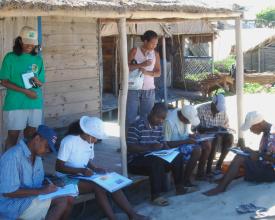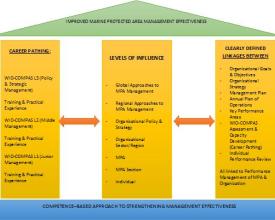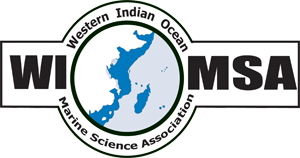Competence-based capacity development for effective MPA management

Western Indian Ocean – Certification of Marine Protected Area Professionals (WIO-COMPAS) is a competence-based approach to individual and organizational capacity development to address the problem of ineffective MPA management in the region, principally for the conservation agencies mandated with this task. To date it has certified 68 MPA personnel in 8 countries and has been integrated into the human resource management of 2 agencies, the Kenya Wildlife Service, and in South Africa, CapeNature.
Context
Challenges addressed
- Ineffective MPA management
- Limited competence of MPA personnel
- Lack of dedicated MPA personnel and career pathing for MPA professionals
- Limited resources
- Limited collaboration within and across agencies
- Lack of understanding of MPAs in agencies and governments
- Increasing pressure on marine resources
- Increasing political pressures for community beneficiation from marine resources and MPAs
Location
Process
Summary of the process
- The competences are the foundation of the whole process, on which everything else is built.
- The assessment instruments and tools are the means by which individuals’ competence is assessed against the competences. This establishes their real level of competence, identifies gaps requiring capacity building, and identifies those individuals with particular potential for career advancement. They, with the competences therefore provide the framework for the career pathing of the left-hand column.
- The certification events provide professional recognition for competent personnel, and establish clear benchmarks for professional development and Key Performance Indicators. They ultimately set the standard for individual, team and organizational ability to fulfil the mandate effectively.
- Institutionalisation integrates all the previous building blocks into a coherent, integrated approach to human resources management for management effectiveness.
Building Blocks
Critical competence requirements
The purpose is to identify the critical competence requirements for effective functioning at all levels. The levels are closely linked having the same competence areas (see below) and with many of the competences within these demonstrating progression in skills and understandings through the levels. Some competences are specific to particular levels. The competences are then used to:
- Establish benchmarks for operations at the three levels
- Provide rigorous criteria for professional certification
- Inform assessment of existing competence and identify competence gaps
- Inform training and other capacity development intervention needs
- Certify MPA personnel who meet the competence requirements as MPA–PROs.
- Inform recruitment, performance review, and promotion processes
- Establish a career path for MPA personnel
- Shape the training provided for MPA personnel
The competences are grouped into 7 ‘Competence Areas’:
- Policy, Legislation and Compliance
- MPA Concept and Establishment
- Communication and Stakeholder Engagement
- Financial Management and Fundraising
- Management Operations
- Biophysical and Sociocultural Environment
- Leadership, Ethics and Innovation
Enabling factors
- Initial focus on one level
- Competence lists developed collaboratively involving a range of perspectives: (M)PA management; science; education and assessment
- Competences grouped into Competence Areas
- Competences sufficiently generic to be widely applicable
- Competences at a fairly broad level with each competence encompassing a range of specific skills
- Competences limited to less than 80 (absolute maximum) to facilitate effective assessment
- Competences supported by Range Statements indicating the level required and evidence relevant to their assessment
Lesson learned
The main lesson is that the identification of the competences must be a collaborative and iterative process. They do not appear overnight, and require consistent focus over a considerable time. The different perspectives are essential, but will pull the process in different directions, with the ultimate outcome inevitably representing something of a compromise. The starting point should probably be the Competence Areas (see the WIO-COMPAS competence lists in the Handbook). The initial focus on one level was a strong feature of the process, avoiding the complication of trying to work at all levels at once. It cannot be stressed too hard that the process of identification of the competences is absolutely central to the whole process, and the competences are the foundation for everything that follows.
Certification tools and instruments
Identifying the most appropriate means of assessing the different competences requires the development of a number of assessment ‘instruments’ to provide varied opportunities for competences to be demonstrated. The instruments should be appropriate both for the type of skill or understanding being assessed, and to the level at which the assessment is taking place. The instruments used by WIO-COMPAS are:
- Application form for initial screening (all Levels)
- Portfolio of evidence comprising documents produced in the workplace (all Levels)
- Core Activity Document/Case study (all Levels)
- Practical demonstration through scenarios (Level 1)
- Written quiz, based on projected images of key species (Level 1); Written test (Level 2)
- Face to face interview (Levels 1 and 2); Panel interview (Level 3)
To develop a system and associated ‘tools’ by which the assessed competences can be marked or ‘scored’. In WIO-COMPAS the most important competences carry a weighting of a possible score of 4 points, with the others weighted at 2 points. A score sheet is used for each instrument, and the scores are transferred to an Excel based ‘Candidate Scoring Package’.
Enabling factors
- Developed by team with strong ‘tacit’ understanding of the field at all levels
- Inclusion of education and assessment specialist
- Establishment of clear criteria for achievement of certification
- Recognition of process as essentially a capacity development and enhancement process – for everyone, including those achieving certification
Lesson learned
It is critical to recognize the differences in the roles and activities performed at the different levels, and the varying requirements for written and/or oral communication skills at these levels. The instruments must therefore be appropriate to the daily work functions at the various levels. Adequate opportunities must be provided for certification candidates to provide evidence of their competences. One instrument is not enough as this can favour some candidates over others. The key concept is that of ‘evidence’, which the instruments are designed to elicit from candidates. A scoring system is essential, as it provides a rigorous measure of the assessments and of the strength of evidence presented through the various instruments by the candidates. The range statements associated with each competence are vital to ensure consistency in assessment and in scoring of evidence between assessors.
Certification events
This building block is concerned with establishing a process for the use of the instruments and tools in assessing the competence of professionals and their suitability for certification. Such a process is known in WIO-COMPAS as an ‘event’, and starts with a call for applications from suitable professionals working at the appropriate level for the certification level focus of the event. The application process provides an initial screening to ensure as far as possible that the applicants have a very reasonable chance of certification. Applicants who are successful become ‘candidates’ and are invited to a 4 day event where the interactive assessment instruments are employed by experienced assessors. Prior to the event portfolios and the case studies are developed by the candidates. Assessors are appointed, following a rigorous selection and training process, and at Levels 1 and 2 each is assigned 3 or 4 candidates, whom they mentor through the process. At Level 3 the assessors work in concert as a panel. The final decision on whether to certify a candidate is not that of the assessors, but of the Certification Board acting on their recommendation.
Enabling factors
- Appointment of appropriately experienced, qualified and trained assessors with a good tacit knowledge of the field and/or assessment processes
- Assessors acting as supportive mentors, rather than as judges
- Inclusion of a rigorous application process
- Provision of clear guidelines on all aspects of the process for applicants/candidates
- Inclusion of a clear appeals process for dis-satisfied candidates
- Established and trusted network which the Certifying Bodies are able to access for engaging organizations to send their staff to Events.
Lesson learned
The quality and commitment of the assessors is paramount. The relationship developed between assessors and candidates needs to be both collegial and disciplined, maintaining the necessary distance while providing the necessary support. In WIO-COMPAS it has been agreed that assessors should preferably not be from the same institution as any of their candidates. While single assessors can have sufficient capacity to assess at Levels 1 and 2, Level 3 assessment requires a panel of specialists working in concert. Assessors, while having individual responsibility for a pool of candidates (except at Level 3), should frequently interact with each other and share the progress of their candidates. Ultimately the recommendations for certification or not, are submitted as a collective decision. Adequate time must be allowed for each stage in the process from initial applications, and for application of all instruments at the event.
Impacts
Impacts have been made at:
Individual level, with 68 certified MPA-PROs. In a survey in 2012:
- 90% of Level 1 and 80% of Level 2 PROs claimed to have become more confident in the execution of their duties
- 90% of Level 1 and 60% of Level 2 PROs said the process had improved their MPA management capabilities
Organisational level, with 2 major conservation agencies:
- Kenya Wildlife Service new HR policy has captured the concept of certification
- 1 out of 9 months ranger training for KWS is now focused on MPAs
- A full curriculum for MPA training is being developed for KWS
- The CEO of CapeNature spoke at the WPC in 2014 in full support of the process of institutionalizing the programme in her organization, warmly recommending this to other agencies
Regional level:
- 90% of Level 1 and 93% of Level 2 PROs stated that WIO-COMPAS had impacted to some extent or greatly on marine conservation in the region
Global Level:
- The IUCN-WCPA Capacity Development Programme cites WIO-COMPAS as a model for competence-based certification and capacity development
Beneficiaries
MPA personnel, managing agencies/organisations, governments, fishers and other marine resource harvesters, scientific community
Story
In Kenya the coastal and marine environment is critical to the survival of species and human offering a wide range of ecosystem services. These include provisioning services like food, and socio-cultural services like tourism which contributes close to 12% of Kenya’s GDP. Competent professionals with a wide range of skills and abilities are critical to the proper management of marine and coastal resources to ensure persistence of species and continued delivery of ecosystem services. Mr Arthur Tuda is one of those marine and coastal professionals who have vast experience in marine conservation in Kenya. Mr Tuda works as a regional manager overseeing the coastal protected areas of Kenya that are under the Kenya Wildlife Service. He is in charge of five marine-protected areas (MPAs) and six terrestrial parks, and oversees a staff of more than 350 people who work in these protected areas. The responsibility that Mr Tuda has is not given lightly. He has earned it, proving his leadership abilities and job capabilities in part through certification as an MPA PRO (Marine Protected Area-Professional) in the Western Indian Ocean Certification of Marine Protected Area Professionals (WIO-COMPAS). Tuda credits his MPA PRO experience with building his confidence and competence in his professional field. In 2008, then a site manager. He was the first Kenyan to achieve Level 2 Site Management Certification. He remains an active leader with MPA PRO by becoming a Level 1 and Level 2 assessor. In this role he assesses the capacity of other East African MPA professionals hoping to get certified at Levels 1 and 2. In 2012 he proved his commitment to the value of the programme by attaining Level 3 Strategy, Policy and Planning Certification. In early 2013 he was promoted to the assistant directorship he now holds. Today, as Mr Tuda oversees more than 2,500 square kilometers of critical habitat, he uses what he has learned as an MPA PRO to take on the challenges of managing expansive conservation areas with limited resources and personnel. He constantly tries new ideas, improves strategies and works to keep his staff motivated. And he shares his MPA PRO-certified expertise every day by mentoring his staff, which he calls a favorite part of his work. Equally important is the leadership role he has taken in WIO-COMPAS to promote the value of MPA PRO certification.



